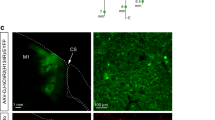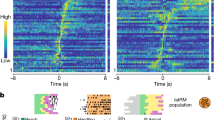Abstract
It is generally accepted that the direct connection from the motor cortex to spinal motor neurons is responsible for dexterous hand movements in primates1,2,3. However, the role of the ‘phylogenetically older’ indirect pathways from the motor cortex to motor neurons, mediated by spinal interneurons, remains elusive. Here we used a novel double-infection technique to interrupt the transmission through the propriospinal neurons (PNs)4,5,6 , which act as a relay of the indirect pathway in macaque monkeys (Macaca fuscata and Macaca mulatta). The PNs were double infected by injection of a highly efficient retrograde gene-transfer vector into their target area and subsequent injection of adeno-associated viral vector at the location of cell somata. This method enabled reversible expression of green fluorescent protein (GFP)-tagged tetanus neurotoxin, thereby permitting the selective and temporal blockade of the motor cortex–PN–motor neuron pathway. This treatment impaired reach and grasp movements, revealing a critical role for the PN-mediated pathway in the control of hand dexterity. Anti-GFP immunohistochemistry visualized the cell bodies and axonal trajectories of the blocked PNs, which confirmed their anatomical connection to motor neurons. This pathway-selective and reversible technique for blocking neural transmission does not depend on cell-specific promoters or transgenic techniques, and is a new and powerful tool for functional dissection in system-level neuroscience studies.
This is a preview of subscription content, access via your institution
Access options
Subscribe to this journal
Receive 51 print issues and online access
$199.00 per year
only $3.90 per issue
Buy this article
- Purchase on Springer Link
- Instant access to full article PDF
Prices may be subject to local taxes which are calculated during checkout




Similar content being viewed by others
References
Lawrence, D. G. & Kuypers, H. G. The functional organization of the motor system in the monkey. I. The effect of bilateral pyramidal lesions. Brain 91, 1–14 (1968)
Kuypers, H. G. A new look at the organization of the motor system. Prog. Brain Res. 57, 381–403 (1982)
Lemon, R. N. Descending pathways in motor control. Annu. Rev. Neurosci. 31, 195–218 (2008)
Alstermark, B. & Lundberg, A. in Muscle Afferents and Spinal Control of Movement (eds Jami, L., Pierrot-Deseilligny, E. & Zytnicki, D.) 327–354 (Pergamon Press, 1992)
Alstermark, B., Isa, T., Ohki, Y. & Saito, Y. Disynaptic pyramidal excitation in forelimb motoneurons mediated via C3–C4 propriospinal neurons in the Macaca fuscata. J. Neurophysiol. 82, 3580–3585 (1999)
Isa, T., Ohki, Y., Seki, K. & Alstermark, B. Properties of propriospinal neurons in the C3–C4 segments mediating disynaptic pyramidal excitation to forelimb motoneurons in the macaque monkey. J. Neurophysiol. 95, 3674–3685 (2006)
Sasaki, S. et al. Dexterous finger movements in primate without monosynaptic corticomotoneuronal excitation. J. Neurophysiol. 92, 3142–3147 (2004)
Nishimura, Y. et al. Time-dependent central compensatory mechanisms of finger dexterity after spinal cord injury. Science 318, 1150–1155 (2007)
Nishimura, Y., Morichika, Y. & Isa, T. A subcortical oscillatory network contributes to recovery of hand dexterity after spinal cord injury. Brain 132, 709–721 (2009)
Alstermark, B. et al. Motor command for precision grip in the macaque monkey can be mediated by spinal interneurons. J. Neurophysiol. 106, 122–126 (2011)
Kato, S. et al. A lentiviral strategy for highly efficient retrograde gene transfer by pseudotyping with fusion envelope glycoprotein. Hum. Gene Ther. 22, 197–206 (2011)
Yamamoto, M. et al. Reversible suppression of glutamatergic neurotransmission of cerebellar granule cells in vivo by genetically manipulated expression of tetanus neurotoxin light chain. J. Neurosci. 23, 6759–6767 (2003)
Gossen, M. & Bujard, H. Tight control of gene expression in mammalian cells by tetracycline-responsive promoters. Proc. Natl Acad. Sci. USA 89, 5547–5551 (1992)
Zhou, X., Vink, M., Klaver, B., Berkhout, B. & Das, A. T. Optimization of the Tet-On system for regulated gene expression through viral evolution. Gene Ther. 13, 1382–1390 (2006)
Alstermark, B., Lindström, S., Lundberg, A. & Sybirska, E. Integration in descending motor pathways controlling the forelimb in the cat. 8. Ascending projection to the lateral reticular nucleus from C3–C4 propriospinal also projecting to forelimb motoneurones. Exp. Brain Res. 42, 282–298 (1981)
Illert, M., Lundberg, A. & Tanaka, R. Integration in descending motor pathways controlling the forelimb in the cat. 3. Convergence on propriospinal neurones transmitting disynaptic excitation from the corticospinal tract and other descending tracts. Exp. Brain Res. 29, 323–346 (1977)
Alstermark, B. & Kümmel, H. Transneuronal transport of wheat germ agglutinin conjugated horseradish peroxidase into last order spinal interneurones projecting to acromio- and spinodeltoideus motoneurones in the cat. 1. Location of labelled interneurones and influence of synaptic activity on the transneuronal transport. Exp. Brain Res. 80, 83–95 (1990)
Kato, S. et al. Selective neural pathway targeting reveals key roles of thalamostriatal projection in the control of visual discrimination. J. Neurosci. 31, 17169–17179 (2011)
Yu, C. R. et al. Spontaneous neural activity is required for the establishment and maintenance of the olfactory sensory map. Neuron 42, 553–566 (2004)
Yizhar, O., Fenno, L. E., Davidson, T. J., Mogri, M. & Deisseroth, K. Optogenetics in neural systems. Neuron 71, 9–34 (2011)
Han, X. et al. A high-light sensitivity optical neural silencer: development and application to optogenetic control of non-human primate cortex. Front. Syst. Neurosci. 5, 18 (2011)
Diester, I. et al. An optogenetic toolbox designed for primates. Nature Neurosci. 14, 387–397 (2011)
Lois, C., Hong, E. J., Pease, S., Brown, E. J. & Baltimore, D. Germline transmission and tissue-specific expression of transgenes delivered by lentiviral vectors. Science 295, 868–872 (2002)
Kaneda, K. et al. Selective optical control of synaptic transmission in the subcortical visual pathway by activation of viral vector-expressed halorhodopsin. PLoS ONE 6, e18452 (2011)
Croyle, M. A., Cheng, X. & Wilson, J. M. Development of formulations that enhance physical stability of viral vectors for gene therapy. Gene Ther. 8, 1281–1290 (2001)
Nakashiba, T., Young, J. Z., McHugh, T. J., Buhl, D. L. & Tonegawa, S. Transgenic inhibition of synaptic transmission reveals role of CA3 output in hippocampal learning. Science 319, 1260–1264 (2008)
Böcker, R. Analysis and quantitation of a metabolite of doxycycline in mice, rats, and humans by high-performance liquid chromatography. J. Chromatogr. 274, 255–262 (1983)
Kato, S. et al. Efficient gene transfer via retrograde transport in rodent and primate brains using a human immunodeficiency virus type 1-based vector pseudotyped with rabies virus glycoprotein. Hum. Gene Ther. 18, 1141–1151 (2007)
Komatsu, Y., Watakabe, A., Hashikawa, T., Tochitani, S. & Yamamori, T. Retinol-binding protein gene is highly expressed in higher-order association areas of the primate neocortex. Cereb. Cortex 15, 96–108 (2005)
Watakabe, A., Komatsu, Y., Ohsawa, S. & Yamamori, T. Fluorescent in situ hybridization technique for cell type identification and characterization in the central nervous system. Methods 52, 367–374 (2010)
Watakabe, A. et al. Comparative analysis of layer-specific genes in Mammalian neocortex. Cereb. Cortex 17, 1918–1933 (2007)
Hioki, H. et al. High-level transgene expression in neurons by lentivirus with Tet-Off system. Neurosci. Res. 63, 149–154 (2009)
Acknowledgements
We thank S. Nakanishi, H. Jingami and C. Akazawa for continuous encouragement. We thank P. Redgrave for comments on the earlier version of the manuscript. This study was supported by the Strategic Research Program for Brain Sciences by the Ministry of Education, Culture, Sports, Science and Technology (MEXT) of Japan. B.A. was supported by the Swedish Research Council. We thank T. Oishi for providing macaque brain sample tissue. We thank P. Phongphanphanee, M. Togawa, Y. Yamanishi, T. Katoh, K. Shimizu, N. Takahashi and K. Takada for technical support.
Author information
Authors and Affiliations
Contributions
Author Contributions M.K., D.W., K.K., B.A. and T.I. designed the experiments and wrote the paper. M.K., B.A., K.I. and T.I. conducted the surgery, behavioural, electrophysiological and histological experiments and analysed the data. R.M., T.H., S.K., H.K., D.W. and K.K. made the viral vectors. A.W. and T.Y. contributed to the histological processing. Y.N. contributed to behavioural analysis and electrophysiological experiments.
Corresponding author
Ethics declarations
Competing interests
The authors declare no competing financial interests.
Supplementary information
Supplementary Information
This file contains Supplementary Figures 1-8, Supplementary Tables 1-2, and Supplementary References. (PDF 1318 kb)
Supplementary Movie 1
This movie shows examples of “precision grip errors” in monkey H. (MOV 5473 kb)
Supplementary Movie 2
This movie shows examples of “slit-hit errors” in monkey K. (MOV 4970 kb)
Supplementary Movie 3
This movie shows examples of “wandering errors” in monkey K. (MOV 5003 kb)
Supplementary Movie 4
This movie shows movement deficit and recovery in monkey H, which mainly showed “precision grip errors”. Reach and grasp movements of monkey H, on days 0, 2, and 5 after the start of Dox administration. Note that extension of the thumb was impaired on day 2, but the movements became normal again on day 5. (MOV 6419 kb)
Supplementary Movie 5
This movie shows movement deficit and recovery in monkey K, which mainly showed “slit-hit errors” and “wandering errors”. Reach and grasp movements of monkey K on days 0, 4, and 8 of the first Dox round (Dox1), days 3 and 7 of the 2nd Dox round (Dox2) and days 2 and 5.5 of the 3rd Dox round (Dox3). Note that the deficit in reaching was repeated and recovered. (MOV 14113 kb)
Rights and permissions
About this article
Cite this article
Kinoshita, M., Matsui, R., Kato, S. et al. Genetic dissection of the circuit for hand dexterity in primates. Nature 487, 235–238 (2012). https://doi.org/10.1038/nature11206
Received:
Accepted:
Published:
Issue Date:
DOI: https://doi.org/10.1038/nature11206
This article is cited by
-
Genetic Approaches for Neural Circuits Dissection in Non-human Primates
Neuroscience Bulletin (2023)
-
Epidural electrical stimulation of the cervical dorsal roots restores voluntary upper limb control in paralyzed monkeys
Nature Neuroscience (2022)
-
Natural and targeted circuit reorganization after spinal cord injury
Nature Neuroscience (2022)
-
Chemogenetic inactivation reveals the inhibitory control function of the prefronto-striatal pathway in the macaque brain
Communications Biology (2021)
-
The neural mechanisms of manual dexterity
Nature Reviews Neuroscience (2021)
Comments
By submitting a comment you agree to abide by our Terms and Community Guidelines. If you find something abusive or that does not comply with our terms or guidelines please flag it as inappropriate.



